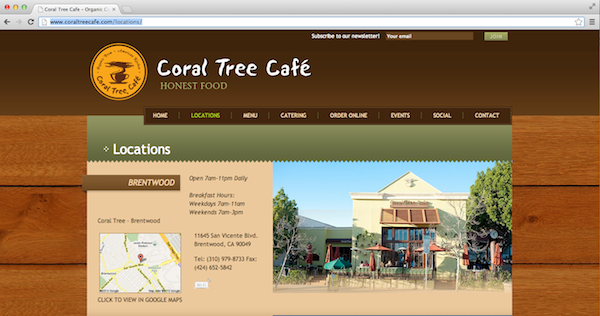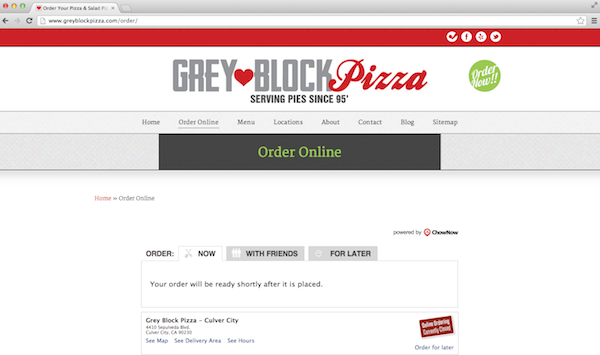
A website is a website is a website, except when it's a restaurant's website. There's something extra tricky about restaurant websites -- they have to be cool, branded, creative, but also simple and clean. And the best ones capture all relevant information in just a few pages. There's no need for deep websites with tons of clicks and pages.
At ChowNow, we stare at restaurant websites all day. And when we're not staring, we're working with clients to help improve and refine their sites to maximize traffic and online orders. While there's no doubt restaurant sites are complex beasts, our marketing team has assembled some proven best practices.
Homepage:
Your website is only as good as your homepage, period. It's just like when people judge a book by its cover, but worse because it costs you customers.

Photos: Beautiful, enticing, high quality photography goes a long way. If you don't have professional photography already, find a friend with a nice camera and a good eye and stage a shoot of your most delicious looking plates. It'll pay off in dividends.
Above the fold: Make sure the action/most important information is happening in the top half of the screen. People are lazy and don't like to scroll.
Navigation menu: Getting around your site should be intuitive. Pages should have generic/industry wide titles like: menu, order online, about us, reservations, contact. Example: Marcello's Pizza and Pasta.
Ask for emails: Customer emails are like gold for a restaurant owner. Create a field for customers to "stay in touch" by entering their contact information. Example: Dragonfly Mandarin.
Location: Make your address clear on the homepage, and as a footer on all pages. Link to a Google Map so directions are easy and highlight any special instructions like where to park or valet. Example: Coral Tree Cafe.
Hours: State your hours clearly. If you're open every day for all meal times, this is less important. But if you're closed every Wednesday, avoid an angry customer and tell them before they make the trip. Update for holidays too!
Reservations:
Chances are a decent percent of your web traffic comes from people who want to know about your reservations policy. Give them answers -- and fast:
Reserving options: We advise our clients that if they choose to take reservations, give at least one other option besides a phone call. That could mean using an online service like Urbanspoon or accepting emailed requests.
No reservations: If you decide you don't want to take reservations, that's cool, but make it abundantly clear.
Menu:
All the restaurant owners we work with spend days, months, even years refining the content, flow, language and look of their hard copy menus -- then we lose them in the transition to digital!

HTML: HTML menus are by far the best option, First, HTML menus are searchable, meaning that Google recognizes the words in the content, and pushes your website toward the top in organic searches. HTML menus are also mobile friendly.
Flash: There's been a trend over the past decade to build Flash (Adobe) sites. Don't do it! They're annoying for customers since they load slowly or incompletely and since they're like giant photos, none of the content on these sites is indexed by search engines.
Online ordering: Online ordering takes a static menu and turns it into a dynamic marketplace for your most engaged customers (those visiting your website). At ChowNow we harness the power of the three most effective channels for online orders: restaurant websites, Facebook and mobile apps. Example: Grey Block Pizza.
Promotions: If you have the same promotions each week, post the calendar and highlight each night's specials.
Story:
Think of your website as one giant story -- are you trying to convey a casual, laid back, cozy story or a loud rock and roll, drink beer out of the bottle type feel?

Chef/management: People love knowing a bit about who's preparing their meal. Tell the story of how the restaurant came to be, where the chef went to culinary school, where the idea for the name came from -- anything memorable and authentic. Example: Zelda's Corner.
Farmers/ingredients: If you spring on seasonal, local or organic ingredients, your website is a great place to promote these special ingredients. Provide a brief description and a link to the farmer/purveyors website.
Social media:
Stay in touch with your customers by providing news and photos on a regular basis.

Blog: Have you considered starting one, or have you already? Blogs are a great way to engage with customers, give your SEO a boost and share news. Example: Ocho Mexican Grill.
Facebook/Twitter: Use the Facebook "like button" and Twitter icon to link to your social media pages so you can stay in touch with your website visitors long term.
Press: Create a page to house all your press hits. Include links to all online articles, logos of the publication and pull out quotes of the most complimentary content. Example: Huckleberry Cafe.
Questions? Concerns? Comment and I'll help as best I can!
Co-written by Lauren Sudekum of ChowNow